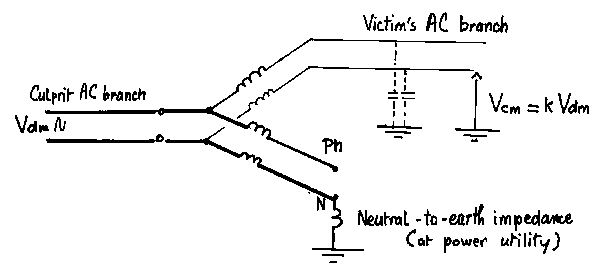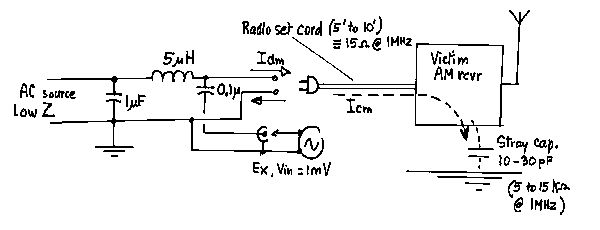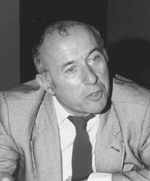
by Michel Mardiguian
Ken Javor’s paper is interesting in many respects. If nothing else, it is an example of what a good engineering attitude should be: don’t rest on acquired ground just because it was established 25 years ago as a standard; question it periodically and ask if the premises are still valid. Then, only if it survives a thorough re-check, keep using it.
However, in this case, I must disagree with Javor on his interpretation of the CBEMA study2 which was the essential foundation for CISPR 22, hence FCC, emissions limits on computing equipment. Javor assumes that, back in 1977, power line CE investigations and modeling were made considering that power return and power earthing reference were a same conductor, such as a one-LISN configuration would represent actual installations. This is not correct. Looking at Figure 5.7 and paragraph 5.6.2 of the CBEMA study, it shows that the “ungrounded neutral” case was taken into account as well, resulting in a 6 dB reinforcement of the limit (see Table 7.1 of CBEMA study). Accordingly, as noted by Javor, the CE setup for single phase (Figure 10.8 of CBEMA) clearly has the two LISNs, as it is practiced today, 25 years later.
The issue remains that CBEMA regarded this as a case for reinforcing the limit, not relaxing it. Let us examine this. Assume, for instance, that the TDI (Threshold for Audible Interference) was found as: Vr(50W) = 1mV with a single LISN type of audio survey (Figure 1). This means that the receiver was, for frequencies below 1 MHz (we are in an AM broadcast scenario), more heavily attacked by Differential Mode (DM) injection than by Common Mode (CM) injection. (The CM loop impedance is quite high at these frequencies, with a floating AC receiver, i.e., less CM current for a given LISN-injected voltage.) However, the DM current path is easily trapped at the receiver AC input by the simple power supply filtering circuit, while the CM current path is uncontrolled, returning by the parasitic capacitance of the radio set PCB to ground and likely doing more harm. The assumption in the CBEMA study was that if the same noise had been injected in phase opposition on line 1 (Ph) and 2 (N), the radio would have seen 2 x Vr.

Figure 1. Typical set-up for evaluating TDI.

Figure 2. DM voltage to CM Voltage conversion along AC distribution.
If the EMI source is a high-Z one (i.e., typically CM, below a MHz), Vr1 and Vr2 are equal, but not out-of-phase, and the victim receiver sees only Vr through a high-Z path. If the EMI source is a low-Z one (as typically DM), the two voltages will indeed add up. This is why the -6 dB adjustment was made.
I think that the real danger, not spelled out in the CBEMA study but certainly implicitly thought of, is that of mode conversion in the utility wiring (urban power distribution inside buildings), where a purely DM-originated noise creates, after some distance, a CM component. Power distribution schemes, especially in Europe, exhibit large variance. Some are using Impedant or Isolated Neutral schemes whereas the Neutral point at the step-down utility transformer is not grounded, causing a mode conversion (Figure 2) with an efficiency which can be greater than -20 dB. Thus, the 20dB derating factor proposed by Javor may not be safe, after all.
Another aspect is a statistical one: it is not sure that the radio sets which are in the upper percentiles of the Vdm TOI (dm mean + 1s) are the same ones which have the highest Vcm TDI (cm mean + 1s). If we allow for Murphy, the prudent approach would be to consider that a certain percentage of Javor’s radio set population had TOI which were a mix of (cm mean + 1s) and (dm mean -1s). In this case, the relaxation for DM-only emissions could probably be of 10 dB (instead of 20), which is still substantial in frequency regions where dBs are expensive to get. Notice that the CISPR 22B limit shown in Javor’s Figures 8 and 10 is wrong; since we are dealing with NB EMI, the average limit of 46 dBµV (close to FCC) should be considered, and not the 56 dBµV quasi-peak limit, as shown.
Finally, another critical aspect not specifically addressed by Javor, but clearly foreseen by CBEMA, CISPR and FCC, was that the conducted limit does not simply protect receivers from power-cord-injected RFI. It also protects from power line radiated RF noise, received by the radio set aerial (ferrite coil antenna for AM). It is not clear in the experiment how much of an effect this played, but I suspect that being in a shielded room, the radiating portion of the power line was short. In actual situations, in the near field of a long wire from a perfectly conductive ground, the radiated H field amounts to:
H(A/m) = I / 2pR (Eq. 1)
Taking the existing CISPR limit of 46dBmV, converted into CM current via the two LISN in parallel, we get:
I(limit) = 46 dBmV - 28 dBW = 18 dBmA, or 9mA
Setting 9mA for I in Eq. 1 produces at 3 cm (Class B distance): H » 0.5mA/m.
Translated artificially into an equivalent E field, using 377W, we get 181mV/m or 45 dBmV/m. The lowest protected useful field in the CBEMA study was 48 dBmV/m, quite close, and this is no mere coincidence.
[1] K. Javor, “Investigation into Radio Susceptibility to Power-Line Conducted Noise,” IEEE EMC Society Newsletter, no. 180, pp. 15-20, Winter 1998.
[2] CBEMA ESC-5 Subcommittee Report: “Limits and Measurement of EM Emanations from EDP and Office Equipment,” May 1977.
 Michel
Mardiguian is an EMC
Michel
Mardiguian is an EMC
consultant in St. Remy les Chevreuse,
France. He can be reached at
Fax No. 33-1-30 52 97 25.